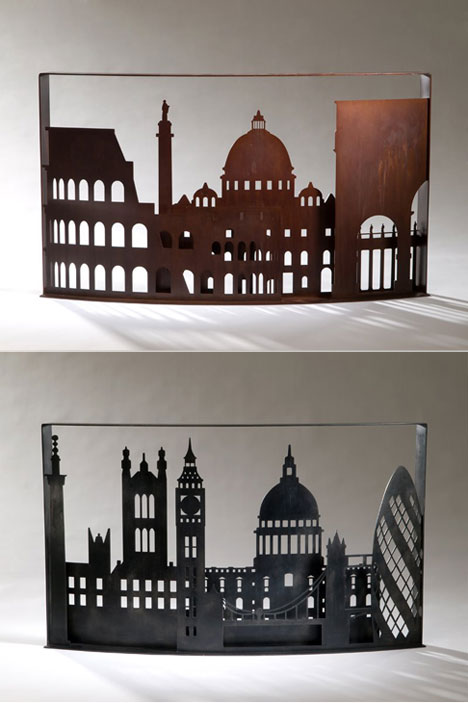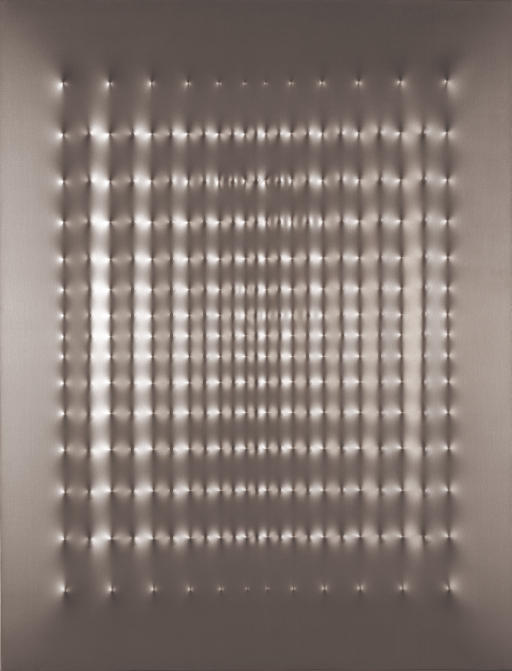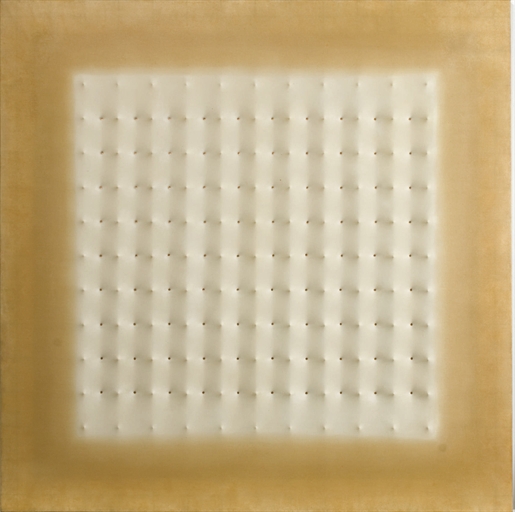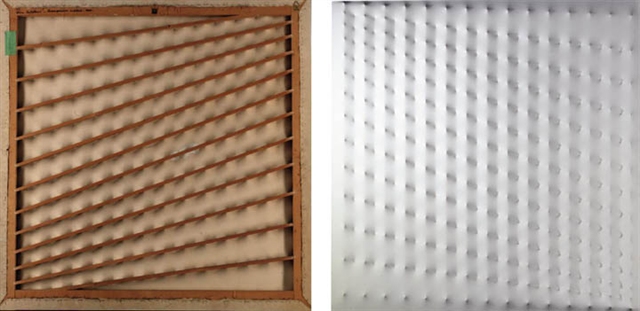The top three finishers at Interlagos on Sunday will be presented with environmentally-friendly recycled plastic trophies.
The Brazilian chemical company Braskem is working from an on-site laboratory and over the three-day event will collect blue caps from disposable drinks bottles.
They will be ground and melted and then pressed into blocks and cut into shape, the blue plastic feature atop a wooden base.
Last year's trophy, designed by Oscar Niemeyer, was constructed of 100 percent recycled plastic. This time around the recycled materials will come from the 60 tons of trash accumulated within the grand prix weekend at Interlagos, the venue which will host the Brazilian Grand Prix.
18.10.09
& Timeless Objects
Design
Seeing Design as Intellectual Rather Than Just Practical
By ALICE RAWSTHORN
LONDON — They look like very ordinary objects. A jug. A bottle. A plate. A table. A lamp. They’re ordinary in shape and size, but there’s one odd thing about them — they seem to have been made from the same sort of metal as historic monuments.
The jug, bottle and so on are part of the collection of Timeless Objects now being produced in the Brooklyn studio of the designers Constantin Boym and Laurene Leon Boym. They really were “ordinary” objects until the couple coated them in what looks like bronze, but is actually their secret formula for a tough type of polymer. “The ‘secret’ is in the way it is applied,” explained Mr. Boym in a joint telephone interview with his wife. “It turns this quite mundane material into something beautiful. The idea is one that has been part of our work for years, to give new life to discarded objects and make people look at them differently.”
You can see the result in “Design USA,” an exhibition of the work of the Boyms and other winners of the first 10 years of the National Design Awards opening Friday at the Cooper-Hewitt National Design Museum in New York. Diverse though SpaceShip One, Google Earth, Apple’s PowerMac G4 computer and the other exhibits are, most of them have one thing in common: they conform to design convention by serving a practical purpose. Not Timeless Objects.
“While the Boyms’ work isn’t typical of product design, it is significant precisely because it questions the nature of that discipline in a way that is simultaneously humorous and serious,” observed Jeannie Kim, co-curator of “Design USA,” in an e-mail interview.
“By obscuring and unifying mundane objects through the application of a material that looks something like dripping bronze, form becomes apparent, function becomes unnecessary and bits of Americana typically found at a flea market suddenly gain the status of a Morandi still life.”
Everyday objects aren’t the Boyms’ only targets. Over the years they have created witty, idiosyncratic, often sinister pieces inspired by the Sears mail order catalog, “missing” monuments that were never built or have been destroyed, and disaster scenes, like the Chernobyl power plant and the tiny Montana cabin where the “Unabomber” plotted his terror campaign. Seen in isolation, their designs can seem kitsch, even tasteless, but together they create a powerful commentary on modern life, especially the dark, unpalatable parts of it that we often choose to ignore.
“Constantin and Laurene use design as a forum for exploring contemporary culture,” said Zoë Ryan, design curator at the Art Institute of Chicago. “Their singular approach illustrates the notion that design is not only about industry or formal and functional considerations, but also about ideas.”
Until recently, treating design as an intellectual medium, rather than a practical one, was rare in Europe and rarer still in the United States, where designers are more deeply rooted in the “build a better world” optimism of 20th-century modernism than in other countries. For years, the Boyms’ conceptual approach cast them as outsiders in American design, as did their obsession with the “undesignerly” phenomena of tragedy and neurosis. They had other “outsider” traits too: Nationality for Mr. Boym, who was born in the Soviet Union and emigrated to the United States in 1981 on a legal technicality; and gender for Ms. Leon Boym, as design is still a boys’ club in America and just about everywhere else. They also came to design from other disciplines. He from architecture, and she art. Those differences remain, but “conceptual design” — or “critical design,” as it is sometimes called — has become increasingly influential, even in the United States, particularly among young designers for whom the Boyms, who are 54 and 45 respectively, look like seers, not mavericks.
The Boyms never planned to work together, but have done so — bickering coquettishly — ever since Mr. Boym asked his wife to help him out with a project. “We flip roles all the time, and pass things back and forth,” she explained. “Working together is still a learning process for us, and we wouldn’t enjoy it as much if we were stuck in caricatures.”
Unlike many younger conceptual designers, the Boyms have also worked commercially, by developing “real” products for companies like Alessi and Authentics, and consulting for Vitra and McDonald’s. “It’s important for every designer to learn how the design world operates, but at a certain point we said enough,” said Mr. Boym. “We wanted to concentrate on our exploratory projects and to control not only the idea but production, timing, marketing, distribution — everything.”
Their involvement in these activities helps to define their work as design, not art, or so the Boyms believe. Since moving their studio from Manhattan to Brooklyn last month, they have extended their experiments with production by opening a workshop. “It’s a little Wedgwood assembly line, where we teach people to work side by side with us,” as Ms. Leon Boym put it. They are also testing new distribution models, including the sale next month of a limited edition of Timeless Objects by Wright, the online auction house. That said, they insist that their work conforms to the traditional definition of design by being functional, even though it doesn’t fulfill a practical role.
“I firmly believe that the idea of function should be redefined to include immaterial uses,” said Mr. Boym. “You can use a Building of Disaster to hammer in a nail, or to elicit an emotional response. What’s more useful?”
& Lasercut cor-ten steel plate
BBM new fireplace screens: 1666 AND DCCCXVII A.U.C., commemorating the great fires of London and Rome, respectively.
Made of lasercut cor-ten steel plate, each screen is produced in the image of the present-day skylines of Rome and London—the background of the fireplace evokes the "fires that signed their history."
Made of lasercut cor-ten steel plate, each screen is produced in the image of the present-day skylines of Rome and London—the background of the fireplace evokes the "fires that signed their history."
16.10.09
& Margaret Anderton
Projects
Current Work
Photography project which is a narrative of the fabric of urban life emphasising personal and private spaces.
Ongoing Projects
Transient Memorials which explores the relatively new phenomenon of placing flowers at the site of death and not the site of burial.
Ordinary Fear concerns photographs of familiar outdoor objects with accompanying text inviting the spectator to reconsider first impressions.


Current Work
Photography project which is a narrative of the fabric of urban life emphasising personal and private spaces.
Ongoing Projects
Transient Memorials which explores the relatively new phenomenon of placing flowers at the site of death and not the site of burial.
Ordinary Fear concerns photographs of familiar outdoor objects with accompanying text inviting the spectator to reconsider first impressions.
Language is a Place, Braille

Language is a Place, Morsecode
Coloured Nail Polish on White Board.

Language is a Place, Semaphor
& Studio Glithero
In a dark room, vases are impregnated with light sensitive chemicals before being kept in light sealed boxes. Like rolls of photographic film, the vases are poised and reactive, ready for the moment we choose to develop them on a rotating spit. By exposing to a UV light, the chemicals develop from clear to vivid Prussian blue, fixing to surface of the vase and leaving an negative of the flowers strapped to the surface like a photographic image. Over one hour, the process slowly captures and immortalises the flowers, a lasting impression of the fleeting life of a cut flower.
Studio Glithero are developing this project with the support of the Vauxhall Collective.
& Rowan Mersh
The essence of my work lies primarily within the complete understanding of a fabric or material. From understanding a textile’s inherent characteristics, from their structure and the way they are knitted, woven or formed, to the yarns used in their construction, an intuitive sense is able to develop. It is this affinity with the cloth that informs possible capabilities and potential for manipulation, and subsequently my creations.



Formed





A collaborative project with Sarah Van Gameren. Conceived as a giant time piece, 100 000 match sticks where aligned like domino's and set ablaze. Lit at 12 noon the piece burnt for 12 hours, the time could be told by the kinetic movement of the flame.



Fabric Sculpture
Future Landscapes




A series of wall based canvases (90cm x 90cm) created utilizing a self-developed technique to permanently form any given fabric into any given shape, conceived as an architectural vision of the future.
Wood

Drawn from the notion of ‘perfection’, seeming faultless spherical wooden sculptures constructed from tooth picks and barbeque skews, were designed with a tumor or growth within the base mold resulting in a geometrically erroneous finish.
& Sarah van Gameren
Burn Burn Burn is the documentation of a performance with a special kind of paint; a flammable paint similar to the colored tip on the end of a matchstick.
When applied, dried and lit, the flame slowly moves forward. It moves over the floor, table legs and chairs where it leaves behind a pitch-black trace, a picture frame burned into the wall and charcoal roses.In the beginning there was my own family tree.
My mother gave me one part of it. For years the scraps of paper had been pressed between the pages of an old photograph album. The other part I received from my grandparents. With the help of some old documents and photographs they tried to recall the names of their nephews and nieces, uncles and aunts.
I wondered if my genealogical research would solve some mysteries. Is the nature of my being a result of the various branches of my family tree that ultimately come together in my own being?
Is the source of our potential in life hidden behind the leaves of this tree? Can my tree tell me how far my talent reaches?
After I completed my own family tree, I stitched all the names of my ancestors on a handkerchief, blew my nose, and that was that.
Then there is Runa, 17 years old. A beautiful and smart girl with many talents. She gave me her genealogical tree to research and in return I made her a necklace. The collier is inspired on the ‘name-jewel’ that girls of her age tend to wear. The piece of jewelry I made for her has every single name of her family members. From her ancestors on her breast to her close family embracing her neck. She wears the collier like a genetic palette.
Subscribe to:
Comments (Atom)











































